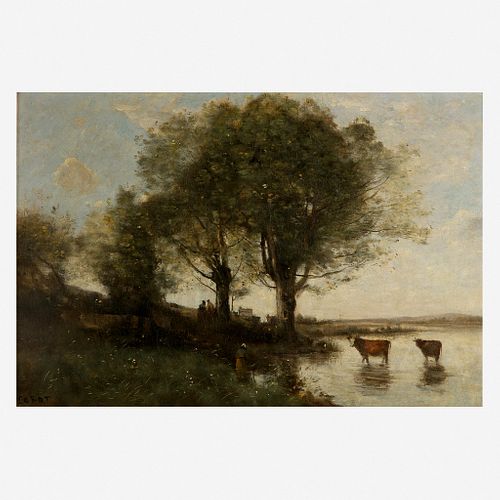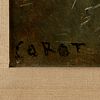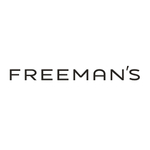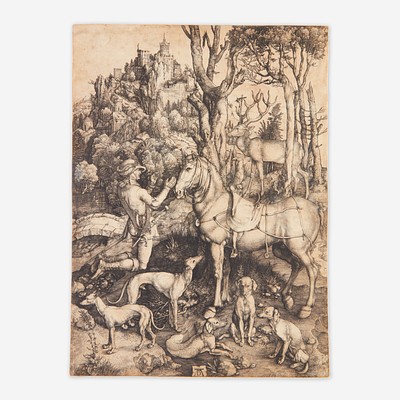Jean-Baptiste-Camille Corot (French, 1796?1875) Le Rappel des Vaches
About Seller
2400 Market St
Philadelphia, PA 19147
United States
Established in 1805, Freeman’s Auction House holds tradition close, with a progressive mind-set towards marketing and promotion, along with access to a team of top experts in the auction business. And now with offices in New England, the Southeast, and on the West Coast, it has never been easier to ...Read more
Two ways to bid:
- Leave a max absentee bid and the platform will bid on your behalf up to your maximum bid during the live auction.
- Bid live during the auction and your bids will be submitted real-time to the auctioneer.
Bid Increments
| Price | Bid Increment |
|---|---|
| $0 | $25 |
| $500 | $50 |
| $1,000 | $100 |
| $2,000 | $200 |
| $3,000 | $250 |
| $5,000 | $500 |
| $10,000 | $1,000 |
| $20,000 | $2,000 |
| $30,000 | $2,500 |
| $50,000 | $5,000 |
| $100,000 | $10,000 |
About Auction
Feb 22, 2022
Auguste Rodin’s Mère et Fille Mourante, a moving mother-and-child sculpture, leads Freeman’s February 22 European Art and Old Masters auction; the work was commissioned by Mrs. Thomas Merrill in 1908 and has remained in the family for over a century. Curated by David Weiss, Head of Sale. Freeman's info@freemansauction.com
- Lot Description
Jean-Baptiste-Camille Corot (French, 1796?1875) Le Rappel des Vaches
Signed 'COROT' bottom left, oil on canvas
20 x 29 1/4 in. (50.8 x 74.3cm)
Executed circa 1870.Provenance
The Artist.
Boussod, Valadon et Cie., Paris, by 1886 (inventory no. 18016).
Acquired directly from the above on December 3, 1889.
Collection of John Parkinson, Boston, Massachusetts.
Newhouse Galleries, New York, New York.
Collection of Mrs. Adolph D. Williams, Richmond, Virginia.
A bequest from the above in 1949.
Virginia Museum of Fine Arts, Richmond, Virginia (accession no. 49.11.6)
Footnote:Exhibited
"Corot," Wildenstein and Company, Inc., New York, New York, October 30-December 6, 1969 (loaned by the Virginia Museum of Fine Arts for the benefit of the Citizens? Committee for Children of New York, Inc.).
Literature
Alfred Robaut, L?Oeuvre de Corot: Catalogue Raisonn? et Illustr?, H. Floury, Paris, 1905, Vol. III, p. 210, no. 1877 (illustrated).
Corot, an exhibition catalogue, Wildenstein and Company, Inc., New York, 1969, cat. no. 72 (illustrated).
Note
Le Rappel des Vaches is a wonderful example of Corot?s later style, and of his ability to capture the fleeting effects of light on the landscape. Executed in the 1870s, just a few years prior to the artist?s death in 1875, the canvas showcases all the hallmarks of his best-known, and most celebrated works. A vach?re seen from behind is depicted in the process of gathering her cows, which appear to have been cooling off in the nearby river. Two distant figures, partly discernible, watch the scene from afar while a glimpse of colored roofs and white facades suggest a faraway hamlet on the break in the horizon. The scene takes place in a verdant, hilly landscape. Freshly blossomed flowers peak through the grass in the foreground while round clouds dot the bright blue sky, and announce a change in weather. The sky is shown transitioning from blue to silvery-gray (a color often associated with Corot?s work after 1850s) and the cows (one of which stares directly at us) stand out as bold masses, shadows almost, emerging from the river. Corot perfectly captures the fleeting moment of cr?puscule, when the landscape is bathed in a half-light that retains much of the beauty, and of the color associated with the setting sun.
Although the work was most likely, at first, painted directly from nature, en plein air, it would be impossible to pinpoint the exact location as Corot never intended to make it too recognizable. The artist was in fact applauded for his talent of covering his tracks i.e. mixing reality with fiction, naturalism with romanticism, sometimes even adding an idealistic aesthetic to his work, so as to create a landscape composed of different influences - a trait which would earn him the nickname of ?Father of Modern Landscape Painting.? The present atmospheric landscape well represents this m?lange through its brushy touch, muted color palette, and overall trembling effect, which suggest a vision rather than just a view, a memory rather than an accurate representation of a locale, reminiscent of the ideals embodied by French Romantic poets Alphonse de Lamartine and Alfred de Musset. Contemporary critics often commented about this unique ability of representation: "M. Corot has a remarkable quality that has eluded most of our artists today: he knows how to invent. His point of departure is always nature, but when he arrives at the interpretation of it, he no longer copies, he remembers it.?
Le Rappel des Vaches departs from Corot?s earlier, almost architectural and oftentimes deserted landscapes. It also veers away from the traditional pastoral and classical landscapes often credited as Corot?s first inspiration. Temples have here been replaced by houses, nymphs by cowgirls and exotic animals by plain and massive farm cows. The scene is filled with a charming spontaneity that makes the painting easy to understand. It is gently animated by the several figures and animals, which evoke a simple, modest way of life. As Georges Bazin explains: ?These are humble village folks, tied to the landscapes to which they are indigenous; they seem to be the rustic incarnation of those creatures and nymphs which fill Corot's "noble" paintings of this period. They travel in carts and on horseback, or simply idle by. By a pond or a river, a fisherman dreams...children keep cattle or play truant. Human toil is for Corot to be kept at arm's length, and the nature that he paints is a kind of Golden Age, where man lives, without too much effort, from the fruits of the field or the milk of his livestock." The bright hues of the golden sun (invisible on the canvas and yet perceptible through its reflecting rays in the river) blend harmoniously with Corot?s distinctive earthy tones, imbuing the whole composition with a natural warmth, a vibrancy that in a way announces Impressionism. This is not surprising, as Corot was often considered to be the bridge between Academism and Impressionism, and is known for having taught several of the soon to be famous artists such as Claude Monet, Claude Pissarro and Berthe Morisot.
- Shipping Info
-
No lot may be removed from Freeman’s premises until the buyer has paid in full the purchase price therefor including Buyer’s Premium or has satisfied such terms that Freeman’s, in its sole discretion, shall require. Subject to the foregoing, all Property shall be paid for and removed by the buyer at his/ her expense within ten (10) days of sale and, if not so removed, may be sold by Freeman’s, or sent by Freeman’s to a third-party storage facility, at the sole risk and charge of the buyer(s), and Freeman’s may prohibit the buyer from participating, directly or indirectly, as a bidder or buyer in any future sale or sales. In addition to other remedies available to Freeman’s by law, Freeman’s reserves the right to impose a late charge of 1.5% per month of the total purchase price on any balance remaining ten (10) days after the day of sale. If Property is not removed by the buyer within ten (10) days, a handling charge of 2% of the total purchase price per month from the tenth day after the sale until removal by the buyer shall be payable to Freeman’s by the buyer. Freeman’s will not be responsible for any loss, damage, theft, or otherwise responsible for any goods left in Freeman’s possession after ten (10) days. If the foregoing conditions or any applicable provisions of law are not complied with, in addition to other remedies available to Freeman’s and the Consignor (including without limitation the right to hold the buyer(s) liable for the bid price) Freeman’s, at its option, may either cancel the sale, retaining as liquidated damages all payments made by the buyer(s), or resell the property. In such event, the buyer(s) shall remain liable for any deficiency in the original purchase price and will also be responsible for all costs, including warehousing, the expense of the ultimate sale, and Freeman’s commission at its regular rates together with all related and incidental charges, including legal fees. Payment is a precondition to removal. Payment shall be by cash, certified check or similar bank draft, or any other method approved by Freeman’s. Checks will not be deemed to constitute payment until cleared. Any exceptions must be made upon Freeman’s written approval of credit prior to sale. In addition, a defaulting buyer will be deemed to have granted and assigned to Freeman’s, a continuing security interest of first priority in any property or money of, or owing to such buyer in Freeman’ possession, and Freeman’s may retain and apply such property or money as collateral security for the obligations due to Freeman’s. Freeman’s shall have all of the rights accorded a secured party under the Pennsylvania Uniform Commercial Code.
-
- Buyer's Premium



 EUR
EUR CAD
CAD AUD
AUD GBP
GBP MXN
MXN HKD
HKD CNY
CNY MYR
MYR SEK
SEK SGD
SGD CHF
CHF THB
THB













